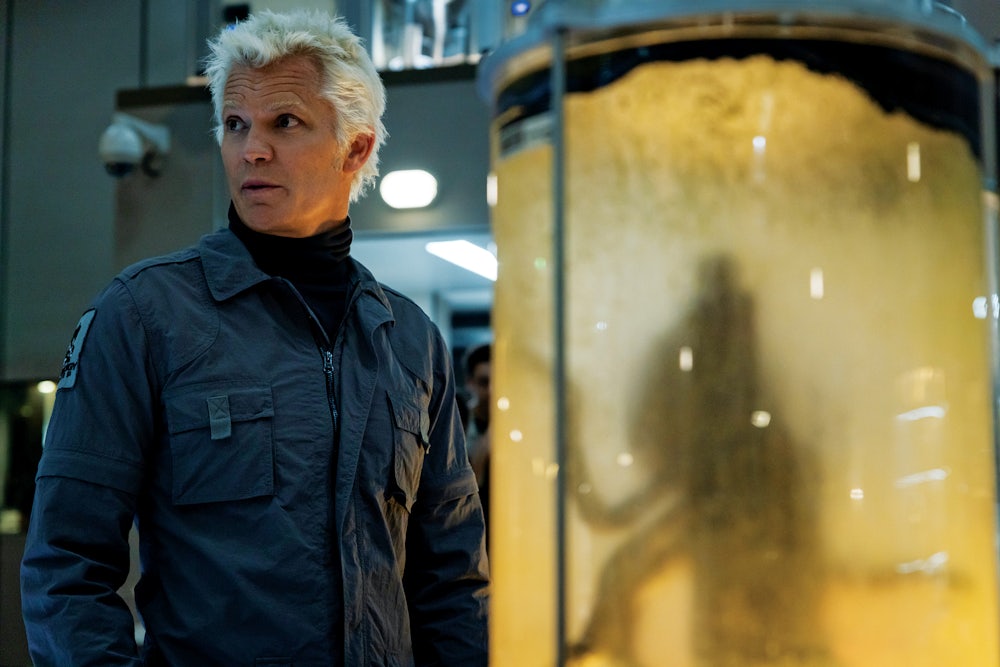FX’s Alien: Earth shreds. In making the first-ever television show based on the Alien film franchise, creator Noah Hawley seems to have had one insight that overwhelmed all the rest: that Alien’s got kind of a heavy metal vibe. This sounds like a criticism, but I don’t necessarily mean it that way. Hawley’s televisual take on the Alien universe is faithful and unfaithful to the canon by turns. It sticks to the basic idea—a group of hapless humans and a handful of charmingly malevolent androids come into contact with a Xenomorph, a parasitic, nigh-unkillable alien bioweapon with a head so overtly phallic that you’d laugh if you weren’t being eviscerated—while ambitiously expanding the scope. It advances strong, strongly asserted ideas about where the most compelling corners of that universe are and how a television show, working at a different scale than film, might illuminate them. Hawley seems quite interested, for instance, in exploring unexplored aspects of the Alien aesthetic. Emerging from H.R. Giger’s perverse, byzantine, industrial Goth artwork, the Alien franchise is full of complex and malevolent piping, snaking alloys, machinelike humans, and humanlike machines.
Alien: Earth obviously draws upon Giger’s blueprint, but, in visual style and thematic spirit, Hawley trades in the franchise’s gloom and doom for something a bit more aligned with metal’s more theatrical aesthetics. This is most evident in each episode’s closing needle drop, many of which are heavy metal classics, including the pilot’s eerily timed Black Sabbath cue. But those are only the most superficial nods. Like the musical genre that inspires the show, Alien: Earth can be grisly and grim as well as occasionally ponderous and plodding—Hawley’s incessant dissolves wouldn’t look out of place in a Metallica video. The show thinks about violence and death in ways that can be bleakly insightful and trite within the space of a scene. It’s dead serious to the point of comedy, but its unembarrassed sincerity is also somehow admirable. And shooting the iconic Xenomorph at length in full light, as the show often has occasion to do, emphasizes the way these aliens look as if they’re clad head-to-toe in black leather. Even from the moment they explode out of the poor human rib cages they’ve been gestating in. Chestbursters and headbangers.
The latent thrash of Alien: Earth is only one of several crannies of the Alien cosmos into which Hawley extends a curious tentacle. The new show is more minutely interested, for instance, in the complex biology and reproductive cycle of the iconic Xenomorph alien than any film in the series, and it spends a tremendous amount of time explicitly explaining and clinically exploring that topic. It is fascinated by the franchise’s depiction of androids, and it situates these beings within a kind of politicized class hierarchy of synthetic, humanoid AI on the planet of their manufacture. It wants to know way, way more about the Earthbound economic environment that led Weyland-Yutani Corp. to put Sigourney Weaver on that ill-fated spaceship in the first place.
Alien: Earth, in other words, has a lot of ideas. So, too, did Alien, Aliens, and all the rest, up through the recent reboots and reimaginings. But all of those films—seven in the canon, along with two crossovers with the Predator universe—shared a kind of brutal simplicity and cutting restraint, the space of the ship serving as a literal representation of the movie’s compulsory narrative economy. The pictures had lots to say about AI and humanity and God and science and bodies and machines, but the language they used was the bloody and direct language of a slasher set on an intergalactic submarine. Even the most philosophically minded of the films, like 2012’s Prometheus, work dirty. (When an enfeebled trillionaire finally meets his alien creator to ask the meaning of life, the giant alien just smacks him so hard he dies.) Given an epic canvas, Hawley introduces new moods and modes to investigate Alien’s enduring themes and images, from boardrooms to futuristic cities to jungle laboratories. But the series often feels as though it’s missing the ruthless, rigid organization of the tin can hurtling through space, its ruminations grander but, given new room to breathe, less urgent. In ways both good and bad, Alien: Earth is not such a tight ship.
There’s a scene in the fourth episode of Alien: Earth when what’s colloquially called a “chestburster” alien infant breaks out of its containment. The creature initially has no legs or arms, and it slithers on its tail like a cobra as it stands, making eye contact with one of our characters. Were chestbursters always snaky guys? In the moment, as I ogled the slippery beast staring from the screen in front of me, I couldn’t quite remember. And the reason for that is that the Alien films have always been defined by speed and darkness. The original chestburster scampers away before you really get a good look at him. The fully grown Xenomorphs dodge in and out of the shadows. In this show, the aliens are well-lit and fully featured. We see them closely, and at length. We probe their strange life cycle, ask and answer questions about them, even hear and try to understand their voices. Some of this makes for fascinating drama. It scratches an itch I have, as a fan, for answers. But part of what made the films so itchily brilliant was their mystery, their play with the dark, their slinking and scampering. Can an extended look at these creatures in the light match the experience of being sideswiped by them in the dark? Are greater mysteries to be found the deeper we go? Can the TV show’s slaking our curiosity replace the visceral thrill of the Xenomorph on the hunt?
Noah Hawley wants to find out. The first moments of the premiere episode—which we encounter in brief snippets and return to at length in a stand-alone episode later in the series—set up our situation quite clearly. A gargantuan spaceship from the Weyland-Yutani Corp., which also chartered most of the vessels we’ve encountered in the film series, has traveled to the far reaches of outer space to bring back five alien species for study and, presumably, profit. One of these fellas is obviously the Xenomorph—contained, however briefly, in an oil-black egg—but there is other compellingly murderous fauna as well, including a scene-stealing octopus monster that looks like a giant eyeball and threatens to become the show’s breakout star.
At the series’ start, the ship has become compromised, as all creatures have broken containment and only one surviving crew member—the cyborg Morrow (Babou Ceesay)—remains to alert the corporate overlords that the ship is about to crash to Earth. It lands in a city controlled by the megacorporation Prodigy, which is run by a young genius named Boy Kavalier, played by Samuel Blenkin as Timothee Chalamet as Willy Wonka on ketamine. Earth, it turns out, is run peaceably if dictatorially by five major corporations, which have divvied up the land masses among them. Prodigy controls large swaths of Asia, while Weyland-Yutani takes the Americas. The crash of the smuggled bioweapons, then, is both an alien invasion and an international business incident.
It’s an R&D boon for Prodigy—which quickly moves to confiscate the cargo—if a poorly timed one. For just as the ship plummeted through the atmosphere, Prodigy was preparing to release its greatest product yet: immortality. In a secret research island far off the coast of the city, Kavalier has managed to download the consciousnesses of six terminally ill children into fully synthetic, superhuman adult bodies, which, provided they charge up regularly in whimsically Apple-coded chargers, ought to live forever. Kavalier calls the squad the Lost Boys, even though half are girls, and all are named after characters from Peter Pan, including the first of them, their de facto leader, Wendy (Sydney Chandler). Again, this alone is an engaging concept, even without the Alien mythology. The actors in these roles have a great time playing little children suddenly operating twentysomething bods that can lift enormous objects and leap high into the sky. The gimmick could easily become tiresome, but it’s a credit to the talent—starting with Chandler—that it doesn’t. The show invents a variety of ways to think about how children might deal with this strange power and stranger loss, and their tenuous balance between humanity and post-humanity is one of the show’s most captivating dramas.
The Lost Boys also, predictably, become the primary adversaries of the titular aliens. The agnostic relationship between androids and Xenomorphs is a recurring theme of the films, and Timothy Olyphant more than ably follows in the tradition of Ian Holm and Michael Fassbender as this show’s resident morally mischievous robot man. But pitting the acid-blooded, parasitic Xenomorphs against a band of unfathomably strong synthetic humans who, for that very reason, cannot become Xenomorph hosts is a fun and fruitful twist. Most Alien films, by necessity, have to deal with the simple question of whether the aliens can be defeated. This show asks loads more questions, including, possibly, improbably: Can they be friends?
On its own, almost every narrative space Hawley’s built out for Alien: Earth is more than enough to hold my interest. The corporate espionage, the AI stuff, the existential philosophizing, and, of course, the good, old-fashioned blood and acid and guts—everything works. But, in thinking bigger than the hull of a compromised ship and the run time of a feature film for this television series, Hawley may not have thought big enough. Eight episodes is certainly more than a two-hour movie, but it’s also not that much space. Cramming together all of these new settings and intrigues while paying homage to the original mythology, Alien: Earth manages to suggest a wider set of questions without really having the time to dig too far into them. And rather than contrive a uniquely televisual set of constraints—like Andor’s three-episode arc structure or The Pitt’s real-time immersion—to replace the cinematic ones that define the film series, Alien: Earth feels oddly, surprisingly loose.
As this new show hurtled by, I felt the visceral excitement of its creator, the explosion of his ideas, his genuine love for the material. At times, it electrified me the way the best of the Alien films do. At other times, the barrage of sounds and sensations began to blur together. Xenomorphs, like heavy metal musicians, live off of speed and darkness, but the only way they can do that is through uncanny precision. The fathomless noise and the flawless execution wash over you. Sometimes, at a heavy metal show, the transcendent tangle of the mosh pit makes you feel at one with the people around you, the community of fans and fanatics, the fellow devotees to this violent beauty. Sometimes you’re just getting pushed around.




